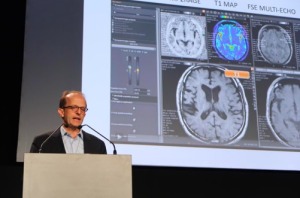by
Lauren Dubinsky, Senior Reporter | July 10, 2018

Professor Vincent Dousset speaking
at the meeting in France
Canon Medical showcased its new Ultra-High-Resolution research-enabled 3T MR System last month at the ISMRM-ESMRMB 2018 Joint Annual Meeting in Paris, France.
At the meeting, Professor Vincent Dousset of Bourdeaux University reported that the higher performance gradients within this system can lead to better signal-to-noise spatial resolution for neurological applications.
“That allows researchers to image deeper into brain anatomy like the hippocampus and brain micro structure,” Gavin Buffet, integrated marketing communications for Canon, told HCB News.



Ad Statistics
Times Displayed: 45604
Times Visited: 1365 MIT labs, experts in Multi-Vendor component level repair of: MRI Coils, RF amplifiers, Gradient Amplifiers Contrast Media Injectors. System repairs, sub-assembly repairs, component level repairs, refurbish/calibrate. info@mitlabsusa.com/+1 (305) 470-8013
According to Canon, this system has the highest peak gradient amplitude specification of 100 mT/m at 200 T/m/s. It can reach the maximum slew rate simultaneously to deliver high whole-body MR performance.
This MR enables users to participate in the Human Connectome project, pharma-sponsored or NIH-level clinical research that requires more specific system specifications that are not typically available on clinical MR systems.
The system also features the company’s AI-based Deep Learning Reconstruction (DLR) technology, which was
created in collaboration with Kumamoto University and Bourdeaux University. When the DLR technology is used in conjunction with Canon’s 3T MR system, it generates images comparable to those acquired with a 7T MR system.
Buffet noted that this technology can help reduce noise and clean up images.
“Removal of artifacts and more clear delineation between white and grey matter will help improve diagnosis,” he added. “This will allow for more accurate and quantifiable research moving forward.”

